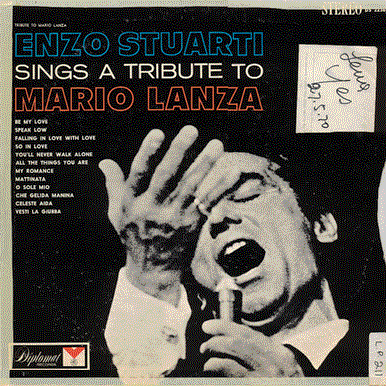

ENZO STUARTI SINGS A TRIBUTE TO MARIO LANZA

(
View LP Cover
)
TRIBUTE
TO MARIO LANZA
|
A SIDE BE MY LOVE SO IN LOVE O SOLE MIO MY ROMANCE VESTI LA GIUBBA YOU'LL NEVER WALK ALONE |
B SIDE ALL THE THINGS YOU ARE SPEAK LOW CHE GELIDE MANINA MATTINATA CELESTE AIDA FALLING IN LOVE WITH LOVE |
|
|||
|
|
BE MY LOVE | ||
|
|
SO IN LOVE | ||
|
|
O SOLE MIO | ||
|
|
MY ROMANCE | ||
|
|
VESTI LA GIUBBA | ||
|
|
YOU'LL NEVER WALK ALONE | ||
|
|
ALL THE THINGS YOU ARE | ||
|
|
SPEAK LOW | ||
|
|
CHE GELIDE MANINA | ||
|
|
MATTINATA | ||
|
|
CELESTE AIDA | ||
|
|
FALLING IN LOVE WITH LOVE | ||
| The history of Mario
Lanza's success is an unusual tale that happened in story-book fashion.
As in a movie, this great tenor never sung a note before he was twenty. Yet, by the time he was thirty, he was known all over the world as one of the greatest tenors ever to live. Mario Lanza was born Alfred Arnold Cocozza in Philadelphia's Little Italy. It was later on, that the great Serge Koussevitzky suggested he change his name; so Alfred adopted the masculine version of his mother's name—Mario, and then took her maiden name—Lanza. As a boy, Mario Lanza was always very active in sports. In fact, he lays claim that his interest in sports actually prevented him from becoming a delinquent. He was an avid baseball player, an excellent boxer, and even at one time, he played semi-pro football. He was constantly fooling around with weights and at fourteen he could lift almost 200 pounds. As a child, he studied the violin, but in a fit of rage the teacher threw his violin out the window. Piano lessons which later followed also led to naught. Around the corner from where his grandfather, Salvatore Lanza, operates a small grocery, is a record shop run by a "Pop" Iannarelli. "Pop" not only sells records here but he also plays them for his own satisfaction. Of course, neapolitan songs and operas are the featured records on the program of his little record shop. Mario Lanza's interest in opera came from listening to these records and even at a very early age the opera tenors and neapolitan songs gave him the shivers. One afternoon as Mario Lanza was listening to one of the famous operas sung by Caruso, he claims that he doesn't know exactly what happened but that he opened his mouth and started to sing. Hence, one of the world's greatest tenors was born. Mario Lanza began to take voice lessons shortly after that happened. He also worked as a piano mover in order to support himself. It was while moving a piano, in the tamous _Academy of Music in Philadelphia, that Mario was to give his impromptu audition that led to hii becoming a star. While moving a piano, he saw William K. Huff, the impresario of a local concert series. Huff recognized Mario as a voice student of a friend of his and led him back-stage where Dr. Koussevitzky, who had just finished rehearsing with the visiting Boston Symphony, was changing his shirt. Huff brought Mario Lazza to an adjoining room and told him to sing. As soon as the first few notes left his throat, Dr. Koussevitzky rushed in and said that this is the greatest natural tenor voice since Caruso. Lanza was then signed up for a series of concerts at Tanglewood, in the Berkshires. Of course, the rest is history. Mario Lanza was in the army for five years where he sang in "On The Beam" and "Winged Victory". He later appeared at the Hollywood Bowl where Louis B. Mayer signed him to a seyen-year contract for M-G-M pictures. Some of the movies he made were "That Midnight Kiss", "Toast of New Orleans" and "The Great Caruso". Whenever you buy a Spinorama Album you are buying one of the greatest record values in the world. The quality of the material used in its manufacture; the exclusive process employed in the pressings; the fine protective nature of its packaging; the superior method of HI-Fl recording technique and the care used in finishing, all contribute their part in producing an excellent disc. This album, is of equal quality to brands costing twice as much and more. We urge you to handle this record carefully, use only the best needles and treat it kindly. If you do, it will repay that kindness in years of pleasure and musical enjoyment. TECHNICAL DATA This particular record was recorded on an Ampex Model 300 Tape Machine using Telefunken, Neumann, EV 667 Microphones. The Masters were cut on a fully automatic Scully Lathe with Miller Cutter Heads driven by specially designed 200 Watt McIntosh Amplifier. The total freauency range of 15 CPS to 25,000 CPS is on this record, however, it is not within the range of the human ear. It is included in the mastering because of the feeling , that this upper and lower range of frequency responses provided the listener with a more rounded tone and gives the recording a lush sound. This recording may be played on any 331/4 RPM record playing instrument; but the wide range and fine technical features incorporated in this record will be most fully realized on playback equipment of extreme high fidelity. Low Frequency Limit 15 CPS High Frequency Limit 25,000 CPS crossover 500 CPS Rolloff 13.75 DS at 10 KC |

